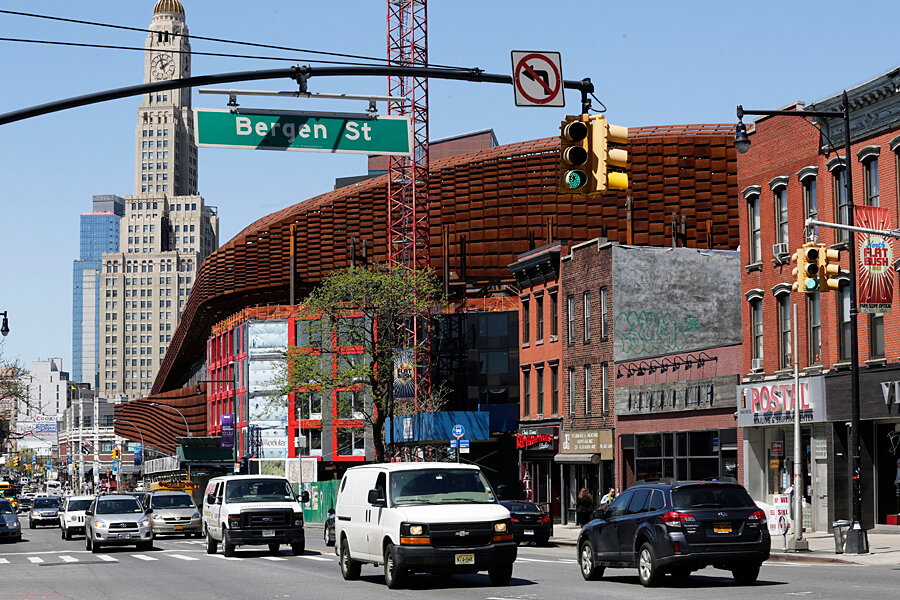Lead foots beware: why New York is cracking down on them
Loading...
| New York
For many New Yorkers, the American love affair with the automobile is more like going on a date now and then. It’s fun, it’s a nice getaway distraction, but getting around in the city usually means hopping on the subway or jumping in a cab.
While New York has never been the most car-friendly American metropolis, on Monday city law enforcement will embark on a three-week ticket-writing frenzy.
Through July 6, the New York Police Department will be cracking down on hosts of scofflaws behind the wheel, conducting a carefully planned surge in its enforcement of city speed limits and other rules of the road. One-armed drivers glancing down and thumbing texts beware.
“The traffic safety operation will focus on the most problematic intersections around the city and take place during all hours of the day,” the department announced.
Monday’s initiative actually marks the fourth ticket-writing blitz in about a month for the NYPD, as city officials begin to ramp up Mayor Bill de Blasio’s ambitious “Vision Zero” traffic plan. The plan seeks to eliminate as many of the city’s 4,000 serious injuries and 250 car-related fatalities each year as possible.
“This status quo is unacceptable,” reads the city’s Vision Zero Action Plan, an initiative that Mayor de Blasio promised throughout the election campaign last year. “The City of New York must no longer regard traffic crashes as mere ‘accidents,’ but rather as preventable incidents that can be systematically addressed. No level of fatality on City streets is inevitable or acceptable. This Vision Zero Action Plan is the City's foundation for ending traffic deaths and injuries on our streets.”
Last month, the NYPD took two days to go after those who texted while driving or who failed to yield to pedestrians – a surge in which police wrote more than 5,000 tickets. The following weekend, the traffic unit zeroed in on speeders, issuing just under 5,000 summonses. Then, a week later, the NYPD conducted a full enforcement surge that lasted seven days. Now traffic cops will do the same for three full weeks, with more surges likely throughout the summer.
“I definitely noticed an increase in tickets,” says Kristin Samadi, a resident of Bay Ridge in Brooklyn and a member of the performing arts faculty at Adelphi University in Garden City, N.Y. “I’ve been driving in the city for 10 years now – at least five days a week, too – and I got my first speeding ticket in a long, long time last month. It’s been years.”
Ms. Samadi, also a concert pianist and private instructor, travels throughout four of New York’s five boroughs every week to give piano lessons, and on weekends she drives to New Jersey, where she is a church music director. She was driving in Queens when she was caught going 45 miles per hour in a 35 m.p.h. zone – the standard speed limit for all city streets.
“I understand that they need to write these tickets: Maybe there are too many deaths and injuries happening,” she says. “There’s also a protocol that the city needs to make money as well, I’m sure. But it’s just frustrating. I never drive like a maniac or anything, and I never get speeding tickets. But of course everyone thinks that it’s unfair when it happens to them.”
So far, the initiative appears to be having an effect: Pedestrian deaths have dropped more than 30 percent since de Blasio took office, according the NYPD.
Still, owning a car just doesn’t have the same status-making cachet in a city that lives more vertically than most. And not many New Yorkers spend as much time behind the wheel as Samadi does every day.
Manhattan is mostly a rumble of delivery trucks surrounded by a hive of zipping yellow cabs, which carry about a half million people to their destinations each day. And with some 7 million riders taking to the subterranean mazes of subways to get around on an average workday – more than the populations of Los Angeles and Chicago combined – the rhythms of life in New York aren’t as defined by the car as they are in much of the rest of the country.
But the Vision Zero idea, originating in Sweden in 1994 with the simple understanding that “no loss of life is acceptable,” has found its way into a number of American lawmakers’ minds. According to New York City officials, Vision Zero-like programs have reduced traffic fatalities by 43 percent in Minnesota, 48 percent in Utah, and 40 percent in Washington State.
In addition to traffic law enforcement surges, New York City lawmakers have begun to introduce new laws establishing a permanent Vision Zero task force, collecting traffic data and gathering input from the city’s drivers, and investing in more advanced speed-detection equipment.
The de Blasio administration is also beginning to lobby the state Legislature to lower the citywide speed limit to 25 m.p.h., install speed and red-light cameras, and increase the penalties for traffic violations – each of which needs state approval.
“We will save lives,” de Blasio said when he introduced the Vision Zero Action Plan earlier this year. “And that work begins in earnest today. But just as this effort has grown from the grassroots, its success will depend on everyday New Yorkers, neighborhood groups and communities coming together and working in common purpose.”
The surge in summons, too, has gotten Samadi’s attention: “I would say, yes, I’m definitely more aware now, driving.”








